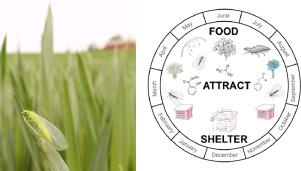Basic and Applied Ecology ( IF 3.8 ) Pub Date : 2021-01-22 , DOI: 10.1016/j.baae.2021.01.004 Gunda Thöming , Geir K. Knudsen

|
Conservation biological control (CBC) is a promising tool for ecological intensification that aims to establish resilient natural enemy populations that contribute to pest management with reduced use of pesticides and at the same time support native biodiversity in agroecosystems. Yet the impact of natural enemies in CBC is often limited due to missing resources such as food, habitat, and hibernation shelters. Here, we studied a CBC strategy that incorporates these essential resources combined with semiochemicals, focusing on how the common green lacewing can enhance biological control of aphids.
In a 4-year field study conducted at three locations in the region of East Norway, we developed a CBC strategy combining the three measures ATTRACT (a ternary attractant that increase lacewing egg laying), FOOD (floral buffer strips), and SHELTER (insect hotels for overwintering survival) to increase aphid biological control in spring barley. We recorded the number of lacewings, ladybirds, hoverflies, parasitized aphid mummies, and the two cereal aphid species Sitobion avenae and Rhopalosiphum padi. Our CBC strategy resulted in a significant increase in lacewing activity and significant aphid suppression. At all three locations and over the 4-year period, aphid infestation was below the economic damage threshold in the field plots using CBC measures. In contrast, during two of the years, the density of the aphid infestation in the control plots was significantly above the damage threshold. We found evidence that use of the ternary attractant supported green lacewings but led to loss of ladybirds, hoverflies, and parasitoids, even though flower strips were used as alternative resources.
Our study shows a promising increase in lacewing activity in the agricultural landscape and high biological control of aphids in barley. Long-term field studies are needed to evaluate the impact on non-target species and the agroecosystem before practical application of this approach can be considered.
中文翻译:

利用化学信息素和栖息地操纵来支持绿色lace草活动,以减少农业生态系统中的蚜虫侵扰
保护性生物防治(CBC)是一种用于生态集约化的有前途的工具,旨在建立有复原力的天敌种群,这些种群可通过减少农药的使用来促进有害生物管理,同时支持农业生态系统中的原生生物多样性。然而,由于缺少诸如食物,栖息地和冬眠庇护所之类的资源,天敌在CBC中的影响通常受到限制。在这里,我们研究了将这些基本资源与化学信息素相结合的CBC策略,重点研究了常见的绿色草lace如何增强蚜虫的生物防治能力。
在挪威东部地区三个地点进行的为期4年的野外研究中,我们制定了一项CBC策略,该策略结合了三种措施:ATTRACT(增加lace卵产卵的三元引诱剂),FOOD(花卉缓冲带)和SHELTER(昆虫)越冬生存的酒店),以提高春季大麦的蚜虫生物防治能力。我们记录了草蜻蜓,瓢虫,蚜虫,被寄生的蚜虫木乃伊以及两个谷物蚜虫物种Sitobion avenae和Rhopalosiphum padi的数量。。我们的CBC策略显着增加了草lace活动并显着抑制了蚜虫。在所有这三个地点以及四年内,使用CBC措施,田间样地的蚜虫侵扰均低于经济损害阈值。相反,在两年中,对照样地中蚜虫侵染的密度显着高于破坏阈值。我们发现有证据表明,即使使用花条作为替代资源,三元引诱剂的使用也能支撑绿色的草lace,但会导致瓢虫,蚜虫和拟寄生物的损失。
我们的研究表明,在大麦的农业景观中,lace草活动有希望的增加,而对大麦蚜虫的高度生物控制。在考虑该方法的实际应用之前,需要进行长期的田间研究,以评估对非目标物种和农业生态系统的影响。


























 京公网安备 11010802027423号
京公网安备 11010802027423号